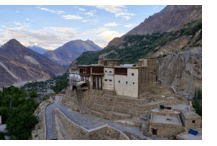INP-WealthPk
Faiza Tehseen
Proper documentation of archaeological sites and ancient inscriptions in Baltistan is necessary to attract international tourists. It would prove a fascinating addition to the annals of the country’s tourist history.

Dr Zakir Hussain Zakir, Head of the Department of Archaeology and Heritage Studies at the University of Baltistan, Skardu (UOBS), expressed these views in an interview with WealthPK. “A lot of places in Baltistan, considered as ancient remains, are still being researched so that a fact file about their historical background could be established. Their proper documentation and periodical classification will reveal interesting facts globally. Besides the archaeological explorations, Baltistan is rich in traditions, dialects, manuscripts, scriptures, paintings, folklore, epics, and sagas belonging to the far-off history. All these tangible and intangible historic assets are direly in need of recording, periodic cataloguing, and conservation,” he said.

Briefly explaining the ancient remains in Baltistan, he said the area remained a cradle and the crossroads of a variety of civilizations. Most of the prehistoric remains belong to Kesarism. Kesar was considered the son of god (called Lha Yokpoon in the local language). He was sent to Miyul (earth) to restore stability and peace, and served the purpose with his wife ‘queen Brogmo’. Most of the folklore in Baltistan is based upon it. In 2009, the epic of celestial King Gesar was inscribed by UNESCO on the representative list of the Intangible Cultural Heritage of Humanity. After that, the remains of Bonism became a part of history. Following the Bon religion, Islamic Sufism took its roots. The remains of unorthodox Bagan beliefs, Shamanism, and Nestorianism were also discovered here (a chapter for further research yet). A series of caves with remains of ancient stone tools, and walls with petroglyphs, carvings of different symbols, and inscriptions also exist here.
Dr Zakir shared an interesting fact about the finding of the remains of the statue of a princess from Kharmang. There was an octagonal lotus flower locket around its neck. Further research on it continues but it is assumed that it was a female Maitreya – the future Buddha. Concluding the discussion, Dr. Zakir said all the described facts were a treasure for historians and a national asset to the country. Their conservation is a matter of quick action. The main reason is that most of these areas are on maps for infrastructure construction. Some of these areas are also under threat due to the mining leases. Only those areas with historic remains must be declared as national assets. So, they must be kept safe from dynamite blasting for mining purposes. There is a need for excavation of more sites to turn more olden pages of the time.
Credit: INP-WealthPk













